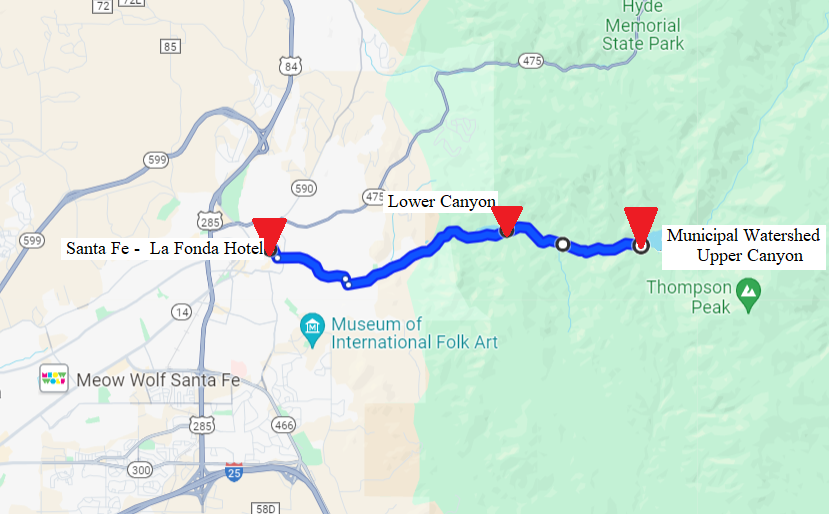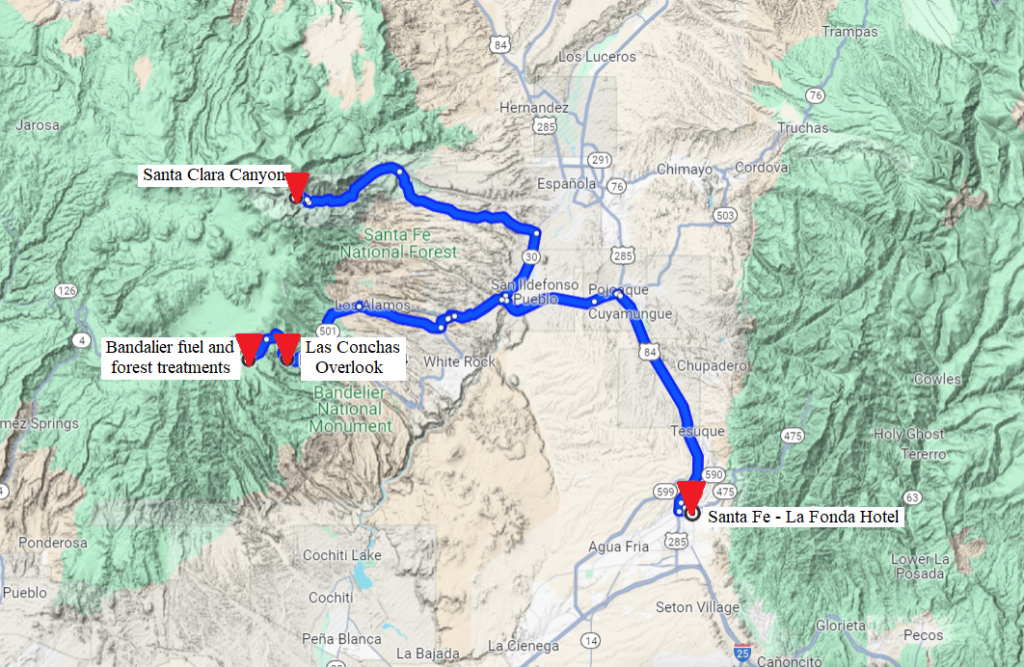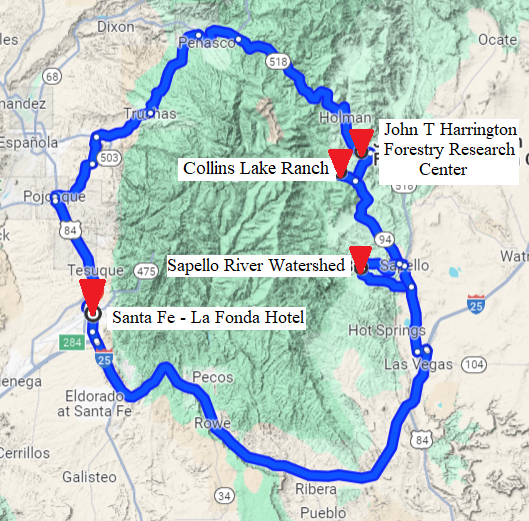Field Trips
Field trips will take place on Friday, November 22, 2024. The cost for each trip is $75, which includes transportation and lunch. The times given below are estimates, and we do not advise planning flights based on the return time (in case unforeseen situations cause a later than expected return).
To add a field trip during registration: After confirming your registration type, click Select Ticket Options and check the box for the workshop you wish to attend (view image of this step). If you are already registered, please log in to the AFE portal, go to Events, My Event Registrations, Click Withdraw/Modify, Click Select Ticket Options, Make selections and save.
Refunds and transfers: You can transfer field trip registration to another person with no charge. You can cancel your field trip registration for a refund until October 18. After that time, refunds will not be issued.
Field Trip 1: Santa Fe Municipal Watershed
The Santa Fe municipal watershed, which provides up to 40% of potable water for the greater Santa Fe area, is located in a narrow and high fire-risk forested canyon just a few miles from downtown Santa Fe. Three decades of collaborative planning, forest resiliency treatments (thinning and prescribed fire), and post-fire debris flow modeling and associated infrastructure upgrades have sought to reduce the watershed’s fire hazard and restore the historical fire regime to protect this vital water source. Learn about the progressive fire management that includes repeated spring and fall broadcast burning; the research on the watershed’s multi-century fire history, changing forest structure and composition, and post-fire debris flow susceptibility; and the lessons that can be learned from a nearby success story of a wildfire that was contained, in part, because of collaborative prescribed burning. Learn more.
Trip length: 5 hours, including 1.5 hours driving time (8:00am – 1:00pm)
Access: Some walking over uneven ground in the forest understory will be offered but optional as part of one tour stop. All stops will include some standing on unpaved surfaces. Accommodations for seating may be made ahead of time.
Field Trip 2: East Jemez Mountains
Many parts of the Jemez Mountains in north-central New Mexico have been impacted by a series of overlapping high-severity fires over the past 30 years, most notably the 2000 Cerro Grande (an escaped prescribed burn), the 2011 Las Conchas that threatened the town and nuclear National Lab of Los Alamos, and the 2022 Cerro Pelado (a pile burn that re-ignited after months under the snow). These fires threatened communities, impacted rural water systems, converted forests to shrub and grasslands, and drastically changed key watersheds, leading to long-lasting, expensive, and culturally impactful erosion and other post-fire water and ecological impacts. They also now offer lessons about high-severity reburns in former frequent-fire forests, the success and limits of forest resilience work in moderating fire severity during wind-driven events in a warming climate, community resiliency, restoration costs, and mosaic fire ecology.
Trip length: 8 hours, including 4 hours driving time (8:00am – 4:00pm)
Access: All stops will include some standing on unpaved surfaces with minimal walking. Accommodations for seating may be made ahead of time.
Field Trip 3: Hermit’s Peak-Calf Canyon Fire Region
The 2022 Hermit’s Peak-Calf Canyon Fire Complex was a devastating event for communities and ecosystems in northern New Mexico. While this fire was unique in its size, severity, driving mechanisms, and causes (an escaped broadcast burn that merged with a re-ignited winter pile burn), climate change and the effects of a century of fire exclusion mean that fires like this one are increasingly likely. Understanding what happened before, during, and after Hermit’s Peak-Calf Canyon can in turn inform our understanding of how to create more resilient communities and forests in the future. Learn about operational decisions made during the fire, pre-planning and forest resiliency treatments which allowed for strategic suppression, lessons learned by local leadership, the ongoing impacts of the fire on communities and watersheds, reforestation as a part of rehabilitation, and a suite of post-fire restoration efforts including debris capture, erosion control, slope stabilization, and more.
Trip length: 9 hours, including 4.25 hours driving time (8:00am – 5:00pm)
Access: All stops will include some standing on unpaved surfaces with minimal walking. Accommodations for seating may be made ahead of time.
Self-Led Trips
Transportation and meals will not be provided for all self-led trip options.
Hiking the Dale Ball Trails
The Dale Ball Trail system is a nearly 25-mile network of natural surface trails located in the foothills of the Sangre de Cristo Mountains. This trail system showcases a variety of southwestern high desert ecosystems and is located immediately adjacent to the Randall Davey Audubon Center and trail system and the City of Santa Fe Municipal Watershed. An feature to meet up with fellow conference attendees for this self-led trip option will be available through the conference app. The trailhead is about a 10-minute drive from La Fonda, and there is adequate parking available.
Trip length: Approximately 2 hours
Cost: free


